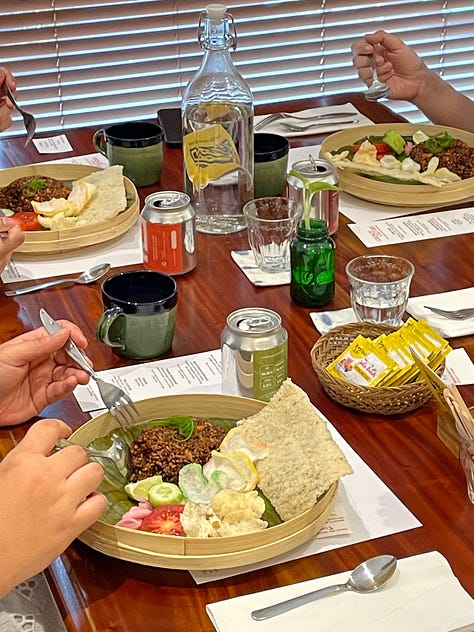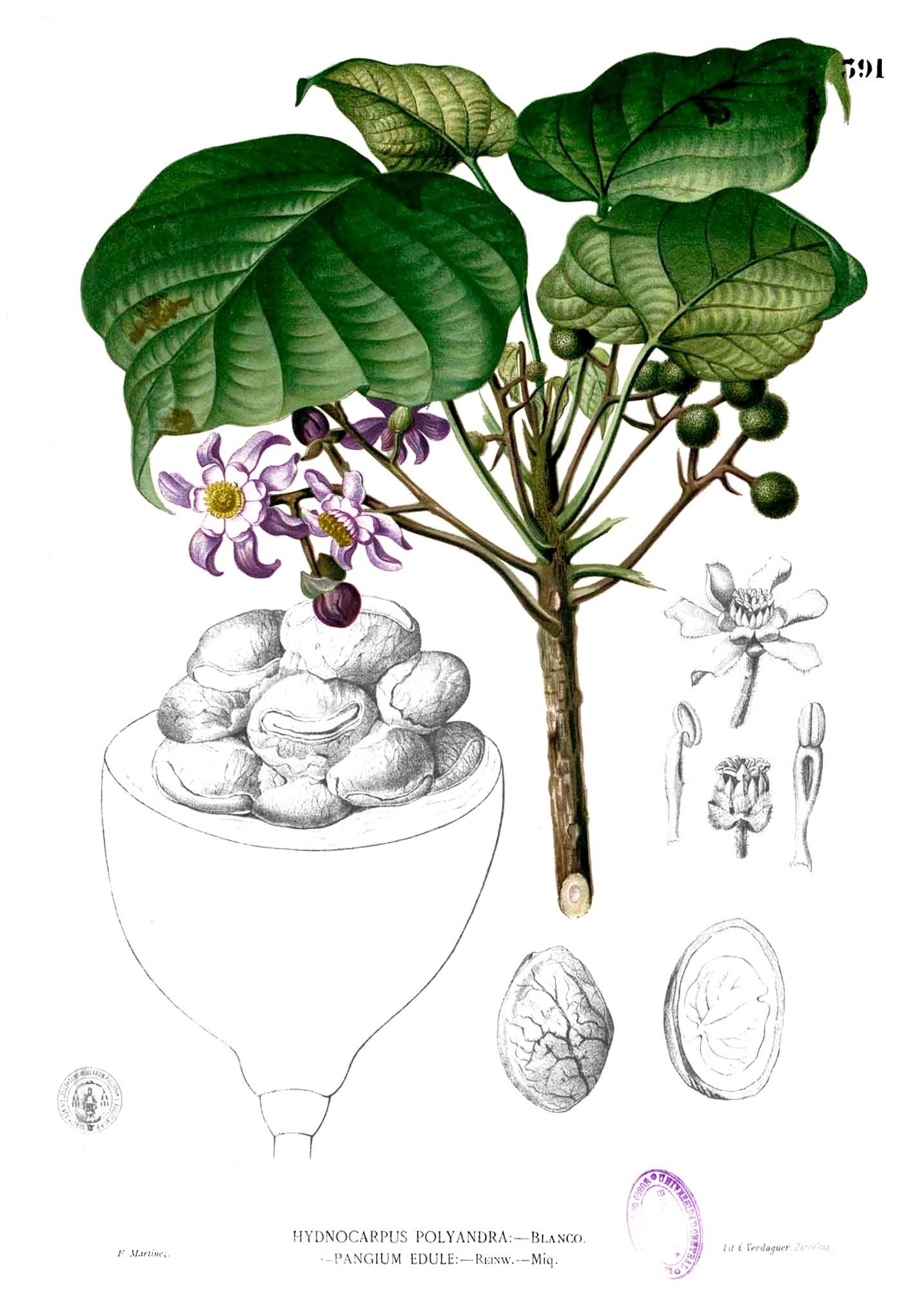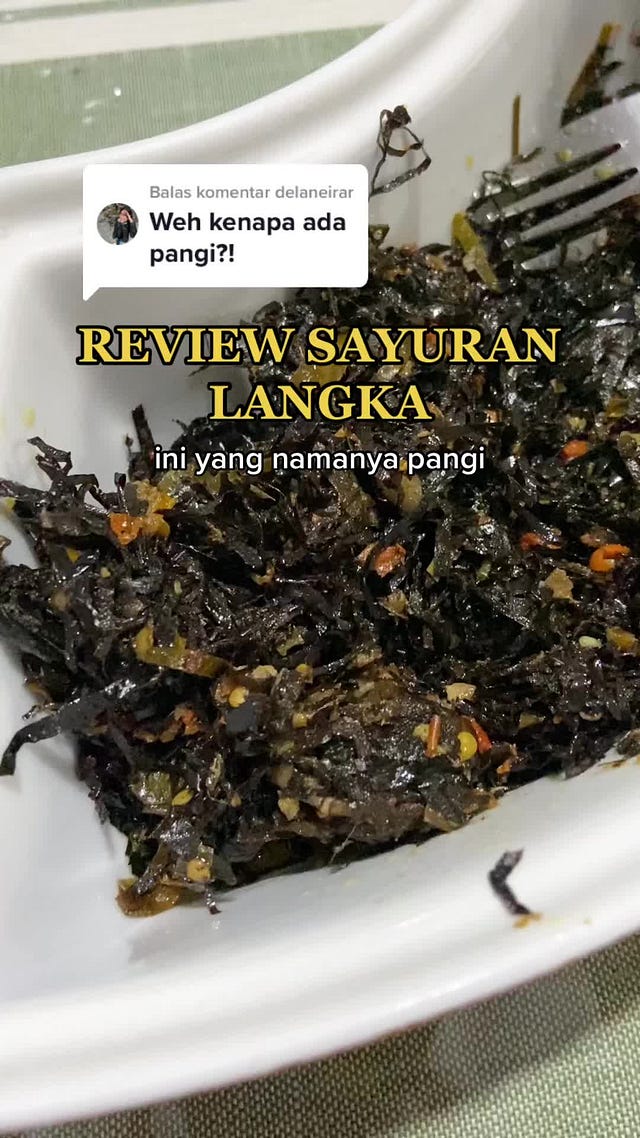Give It a Go: Kepayang
You’ve heard about it and may have tasted it in rawon. But do you really know what it is?
Halo and happy Monday! First off – Eid Mubarak if you’re celebrating. And if this is your first time getting Kepayang in your inbox, welcome! This is where I write essays about food, sustainability, and culture. Occasionally, I also host community hangouts, so make sure to follow Kepayang on Instagram and check it regularly.
Speaking of Instagram, not to flex (maybe a little), but one of my posts went kind of viral recently. Like, thousands-of-shares viral. It was about my latest essay on how food is political. Honestly, I rarely write politically, so it meant a lot to see how much it resonated. Thank you for that.
Anyway, it feels like now is the perfect moment to segue into Kepayang’s newest segment: Give It a Go.
In this segment, I will highlight one Indonesian ingredient that people tend to overlook. For my international friends, consider this your hidden gem moment. I’ll break down what it is, what it tastes like, why it’s worth trying, and how it’s traditionally used.
Also, bonus round, I’ll show how I’d cook it in a slightly less traditional but very fun way. It might not be authentic; it’s just me stretching an ingredient in ways it might not have been stretched before. But hey, experimenting outside the rulebook helps us find new ways to enjoy things.
Today, let’s give kepayang a go.
Kepayang is pangium edule - a native Southeast Asian fruit that is used a lot in Indonesian cuisines and is a pantry staple in the Jawa Timur region, where my family is from. Today, though, most people call the fruit kluwak and not kepayang. My first guess is that kepayang is an outdated name. But my second guess has to be that the name kepayang reminds you of the fact that they’re poisonous.
You see, the kepayang fruit can be intoxicating when eaten fresh. That’s because in its raw form, the fruit contains a pretty high level of cyanide. That’s also where the Indonesian term “mabuk kepayang” comes from, basically meaning you’re drunk on kepayang.
But you shouldn't worry much because the kepayang that you’ll find at the supermarket or in a traditional market is safe. What you’ll find there will be the dried versions of its seeds. The fruits are fermented first, washed until you’re left with the seeds, and dried until they look like a solid gray rock. In this form, kepayang will have low to almost no cyanide content.
Kepayang is free for now, so any engagements mean so much to support the platform’s growth. You can subscribe to get the newsletter sent directly to your email, like, comment, and share if you resonate with what I write.
Alternatively, you can buy me a coffee through my PayPal here: https://paypal.me/chalafabia - or if you’re based in Indonesia, you can send your donation through QRIS here (under the name Tamanan). Any amounts are welcomed and will directly contribute to sustaining this platform to cover expenses related to operations, research, writing, and marketing. ☕️
Kepayang seeds taste like an unsalted, slightly bitter and funky butter.
The first step to cooking with kepayang seeds is cracking them open. The shells are really hard to open, even with a cobek (stone mortar and pestle); it’s a bit of a workout. Scroll down a bit, there’s a video of me opening it.
Once you get them open, you’ll find a dense, meaty flesh inside. The colour can vary. Some are deep black, others lean reddish-brown. In my experience, the redder the flesh, the more bitter it tends to be. So bitter to the point where it overpowers everything else. The darker the seed, the riper it is, and that ripeness helps mellow out the bitterness.
When fully ripe, kepayang seeds taste earthy. The texture is surprisingly soft, almost creamy. You wouldn’t usually eat them on their own, but if you do, you’ll notice a rich, fatty mouthfeel – thanks to their high fat content, which also gives them this unexpected flavour: like an unsalted, slightly bitter and funky butter. Not weird at all.
A few health benefits of eating kepayang seeds are (Halodoc, 2022):
Contains antioxidants: great for boosting the immune system.
High in potassium: helps regulate blood pressure.
High in fibre: makes you poop.
High in iron: supports healthy blood production and helps prevent anaemia.
"Can I taste kepayang somewhere without having to cook it myself?"
If you’re curious to taste kepayang without doing all the cracking and cooking, your best bet is to try rawon, a rich, black beef soup from the Jawa Timur province. In rawon, the kepayang seeds are blended with all the basic bumbu (spices) like shallot, garlic, candlenut, and turmeric. After being blended, they’re sautéed until fragrant and used as a base for the iconic dark colour broths. The typical protein to eat in rawon is beef. But in my house, we use fried tofu.
Another edible part of the kepayang tree is its leaves, often sautéed in dishes like sayur pangi from the Sulawesi Utara province. The bumbu in this dish is pretty extensive. You’ve got the usual like shallots, garlic, ginger, and chilli, but also some aromatic powerhouses like lemongrass, kaffir lime leaves, kemangi, and pandan leaves. All of this is sautéed together with shredded, pre-boiled kepayang leaves, letting the spices cling to each strand, while the leaves themselves still hold a slight bitterness.
I tried adding kepayang seeds in my nasi goreng, and it slapped.
When I first tried to find new ways to add kepayang seeds into a dish, my Indonesian brain jumped into the idea of making it as a nasi goreng (fried rice) base. I’m thinking of bold and black nasi goreng. Since kepayang seeds are fatty, I thought to myself that it would be nice if I balanced it with a lot of bumbu. I want it to be spicy, but not hot spicy. I want the kind of spicy that you would get from nasi kebuli (pilaf).



This nasi goreng turned out so good, I was honestly scared for a second that I might never be able to make it this good again. The first thing I tasted was a warm medley of spices from the ginger, turmeric, and cumin. Then came the deep savouriness from the shallots and garlic, followed by the rich, funky, buttery notes of the kepayang seeds. Everything was tied together with a gentle heat from the red chillies and bird’s eye chillies.
Ingredients (for the bumbu):
4 red chillies (with seeds, I know you can handle it)
3 shallots
5 garlic cloves
3 kepayang seeds, cracked open and scoop the meat
1 tsp coriander seeds
2 candlenuts
1 bird’s eye chilli (skip if you’re WEAK)
1 cm of ginger
1/2 cm of turmeric
1/2 tsp cumin seeds
Coconut oil to sauté
Salt, white pepper, sugar, and MSG to taste
Directions:
Wash all the ingredients (except kepayang seeds) thoroughly and roughly chop them.
For the kepayang seeds, soak the meat in boiling water for at least five minutes. This helps them soften up and removes excess bitterness. Rinse with clean, running water.
Add the above ingredients to a blender with a bit of coconut oil, and blend until smooth.
In a hot pan, preferably nonstick, sauté the spice paste with a pinch of salt until fragrant. Once it smells aromatic, lower the heat and continue cooking until it reduces by half and turns into a thick paste.
This spice base is now ready. You can store it in the fridge for up to a week or in the freezer for up to a month. To use, just mix it with leftover rice to taste, and cook it in a super-hot wok.
Pro tip: Always taste and adjust the seasoning to your liking. Pro tip #2: When cooking in the wok, let the rice sit untouched over high heat for a while to develop that signature smoky flavour.
So the next time you spot kepayang seeds at the market, don’t just walk past them. Behind that tough shell is an ingredient with so much flavour, story, and potential. And I’m proud to be using them as a name for this platform.
What’s one Indonesian ingredient you’ve always been curious about but haven’t tried yet?
Other contents that I made recently:
💥 Read about how bakwan sayur is political: here.
✊ Read about why I’m against Indonesia’s agricultural budget cut: here.
🇹🇼 Read about what I ate in Taiwan, but I won’t tell you about the taste: here.
✈️ Read about why I think aeroplane food deserves more love: here.
🇹🇷 Read on how I learned about Turkiye’s inflation through food: here.
💥 Read about the smart Indonesian crunch culture: here.
If you like today’s newsletter, please like and share it with your friends! Comment down below your thoughts and let me know if you have any other topics you want me to discuss. Until then, I’ll see you in two weeks!
Follow me everywhere:
TikTok: @berusahavegan
Kepayang’s Instagram: @readkepayang
Instagram: @menggemaskan
LinkedIn: Chalafabia Haris
Work with me: readkepayang@gmail.com










Next give it a go about Kecombrang? 😆
Yesterday I tasted Rawon without kluwak... I was like 😦 isnt this penistaan rawon or some sort 😭